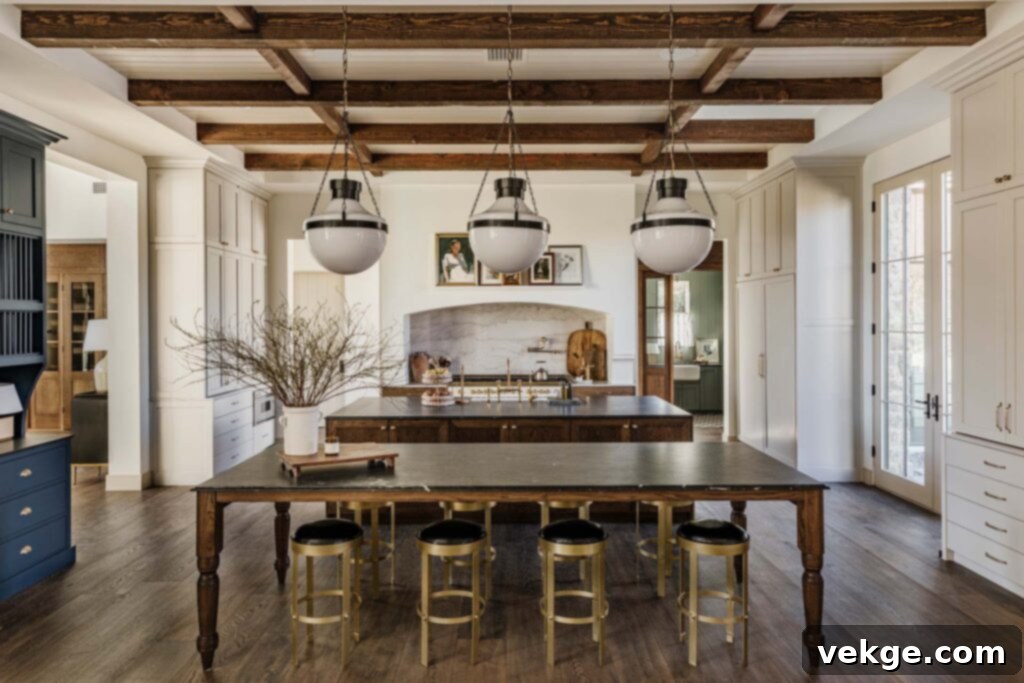Discover Timeless Charm: The Ultimate Guide to English Country Kitchen Colors
English country kitchens are synonymous with a relaxed, laid-back lifestyle, embodying a unique blend of comfort and elegance. These spaces are designed to be the heart of the home, fostering liveliness and adding immense warmth through their distinctive traditional aesthetics. At the core of creating this coveted atmosphere is the thoughtful selection of colors, which often draws profound inspiration from the tranquil beauty of the English countryside.
The essence of English country design lies in its unpretentious charm and functional beauty. It’s about crafting a kitchen that feels lived-in, welcoming, and effortlessly stylish, rather than stark or overly modern. Elements like rustic wooden beams, classic shaker cabinets, and carefully chosen textiles all contribute to an atmosphere of understated luxury. When it comes to color, the palettes are typically soft, muted, and rich in natural tones – think earthy neutrals, delicate pastels, meadow greens, warm browns, and subtle black accents. These hues work in harmony to create a cohesive, calming, and truly authentic English country environment, mirroring the pastoral beauty just beyond the window.
Before embarking on the exciting journey of selecting colors for your English country kitchen, it’s beneficial to refine your vision. Consider two important questions: Do you envision a complete, immersive English country look for the entire kitchen, or do you prefer to highlight just a few specific elements with this distinctive style? Your answers will serve as a guiding compass, helping you navigate the myriad of options and achieve a harmoniously designed space that reflects your personal taste.
In this comprehensive guide, we delve into some of the most captivating color ideas for your English country kitchen. We’ll provide insights, tips, and inspiration to help you transform your culinary space into a charming, timeless haven.
1. Embrace Warmth with a Bright Sunny Yellow for Your Country Kitchen
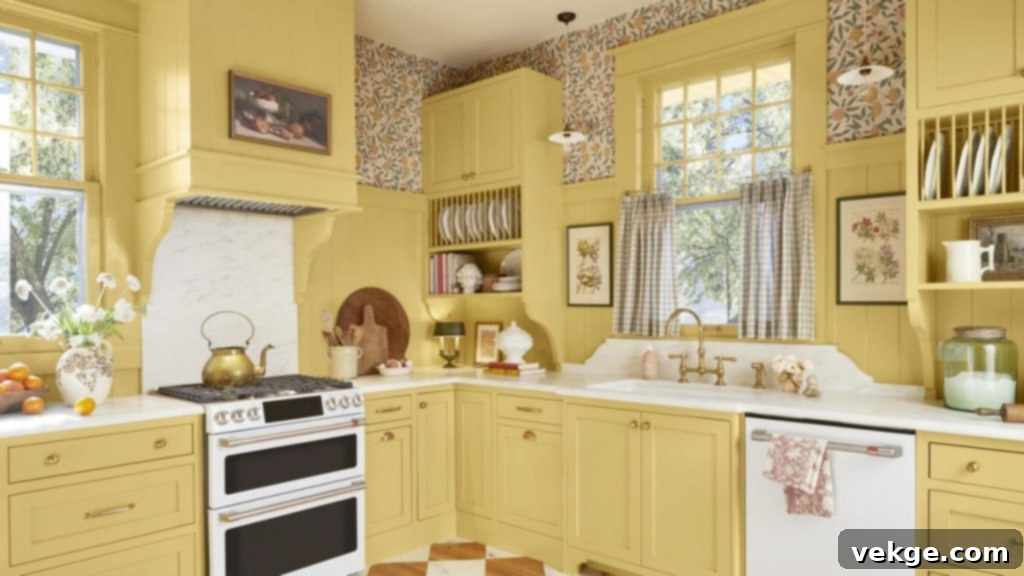
Yellow is a color renowned for its inherent warmth, uplifting cheerfulness, and remarkable ability to alter its appearance based on the quality of light it receives. In an English country kitchen, a carefully chosen yellow can infuse a delightful, sun-kissed radiance, making the room feel incredibly inviting and brimming with life. However, this same versatility can make selecting the perfect shade a subtle challenge.
Before committing to a yellow tone, it is highly recommended to assess the amount and direction of natural light your kitchen receives throughout the day. A soft, buttery yellow might create a cozy, warm ambiance in a north-facing kitchen with less direct sunlight, while a brighter, more vibrant daffodil yellow could be wonderfully energizing in a south-facing room. Always test paint swatches on your walls to observe how the color interacts with your specific lighting conditions.
To avoid an overwhelming “all-yellow” effect, consider using this cheerful hue strategically. Instead of painting all walls, highlight key features such as your kitchen cabinets, a charming built-in pantry, or specific cupboards with a delightful yellow. For the remaining areas, opt for complementary neutral shades like a soft off-white, a pale cream, or a light natural brown. This approach creates a more sophisticated and visually balanced aesthetic, allowing the yellow to serve as a captivating focal point without dominating the entire space. Imagine the charm of pale yellow cabinetry beautifully contrasted with creamy white subway tiles and warm oak countertops – a truly idyllic English country scene.
2. Cultivate a Spacious Appeal with Pale Neutral Shades
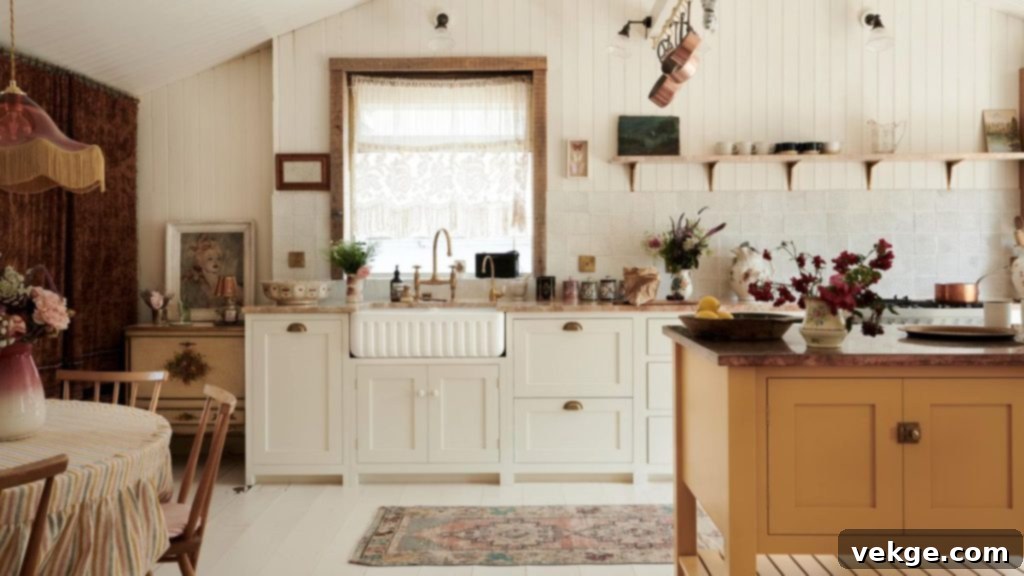
It’s no secret that pale neutral shades are a cornerstone of both contemporary and traditional interior design, and their popularity in English country kitchens is well-deserved. Their enduring appeal stems from their inherently relaxing charm, their soothing effect on the eyes, and their remarkable ability to imbue any space with an understated sophistication. For an English country kitchen, where the goal is often to maximize comfort and create an expansive, airy feel, neutrals are an absolutely indispensable choice.
Neutral hues excel at making spaces appear larger, brighter, cooler, and refreshingly uncluttered. They provide a serene backdrop that allows architectural details, natural materials, and carefully curated accessories to truly shine. The spectrum of neutrals extends far beyond just white; it encompasses a rich array of subtle tones including soft grays, warm beiges, creamy off-whites, versatile greiges (a harmonious blend of gray and beige), and muted taupes. These shades often possess delicate undertones of other colors, which adds depth and ensures the space feels sophisticated rather than bland.
To introduce visual interest without sacrificing the serene quality of neutrals, consider layering different light and dark shades within this palette. For example, a classic and effective approach is to select dark gray cabinets for a grounding presence, pairing them with pale brown or soft beige walls. This creates a sophisticated contrast that subtly defines different zones within the kitchen while maintaining an overall harmonious feel. You could also apply a slightly darker neutral to a kitchen island or a pantry door, crafting a subtle focal point that adds character without overwhelming the room. Don’t shy away from incorporating diverse textures too – a linen-textured wallpaper in a light neutral, or exposed brick painted in an off-white, can add layers of tactile interest and visual depth.
3. Bring Nature Indoors with Serene Olive Green
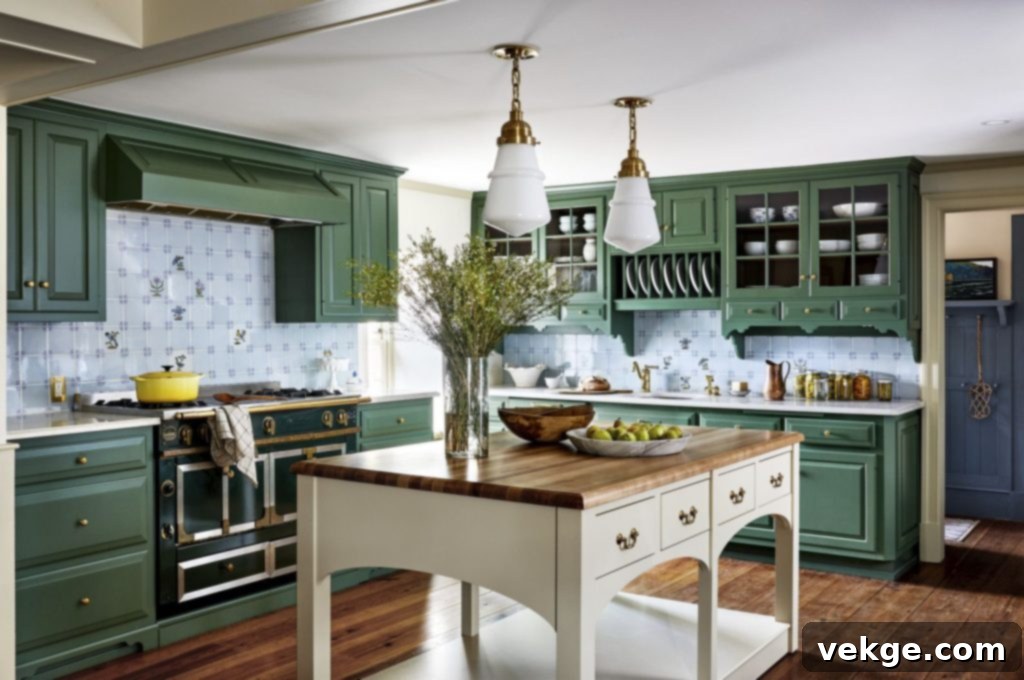
While English kitchens are often characterized by their devotion to pale, muted colors, a vibrant yet earthy shade like olive green can introduce a delightful hint of life and a profound connection to the outdoors. An olive green kitchen evokes the tranquil feeling of a refreshed garden or a peaceful countryside vista, making it an ideal choice for those seeking to infuse their space with natural serenity. This color beautifully bridges the gap between the indoors and the surrounding landscape.
The key to successfully incorporating olive green is thoughtful and strategic application. It is generally advised not to overdo this color; instead, use it sparingly and deliberately to maximize its impact. Olive green pairs beautifully with a range of other colors, allowing for diverse design possibilities. Consider combining it with warm coral accents for a touch of unexpected vibrancy, or a muted blue to enhance its natural, calming essence. Creamy whites, soft beiges, and natural wood tones also make excellent companions, creating a cohesive and inviting palette that feels deeply rooted in nature.
For a sophisticated look, you might choose to paint your kitchen cabinets in a rich olive green while keeping the walls a soft neutral. This approach allows the cabinets to become a striking focal point, offering a stunning contrast that grounds the space. To elevate the luxurious feel, pair olive green cabinets with elegant gold or brass fixtures and hardware. These metallic accents add a touch of glamour and warmth, perfectly complementing the earthy tones of the green. Additionally, consider incorporating olive green into specific areas like an island, a built-in bench, or even a charming vintage dresser repurposed for storage, allowing its natural charm to shine without overwhelming the room.
4. Don’t Hesitate to Involve Thoughtfully Placed Dark Shades
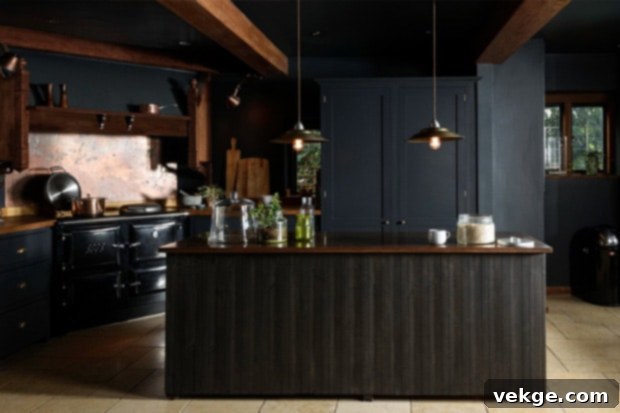
Given the prevalent image of an English country kitchen, often associated with light and airy palettes, it’s understandable that many interior designers might shy away from incorporating too many dark shades. There’s a common misconception that dark colors can make a space appear more congested, unwelcoming, or even drab. However, when applied with careful consideration and strategic placement, dark shades can work beautifully in an English country kitchen, adding depth, sophistication, and a touch of drama that paradoxically enhances its cozy charm.
The trick lies in selective application. Dark colors truly excel on specific elements rather than dominating entire walls. Imagine the profound elegance of deep charcoal, rich forest green, or even a sophisticated navy applied to kitchen cabinets, a commanding island, or a charming shiplap accent wall. When thoughtfully paired with natural wooden furniture, warm stone countertops, or exposed wooden beams, dark colors like a classic black or a deep, inky blue look absolutely stunning. Far from overpowering the space, they create a grounded, authentic feel that perfectly complements the rustic elements so characteristic of this style.
To soften the intensity of dark shades and ensure the kitchen remains inviting, it’s crucial to incorporate elements that introduce lightness and organic texture. Adding living plants brings a refreshing burst of green, while curated artwork or antique décor pieces can break up large expanses of dark color. Strategic lighting, both abundant natural light and carefully designed artificial illumination, is also key to ensuring dark elements don’t absorb all the light. Consider installing warm under-cabinet lighting, elegant pendant lights over an island, or charming wall sconces to illuminate darker areas, creating an inviting and ambient glow that highlights the chosen palette rather than subduing it. This balanced approach allows dark shades to contribute to a sophisticated and truly memorable English country kitchen.
5. The Sophisticated Harmony of Dark Gray with Pale Blue
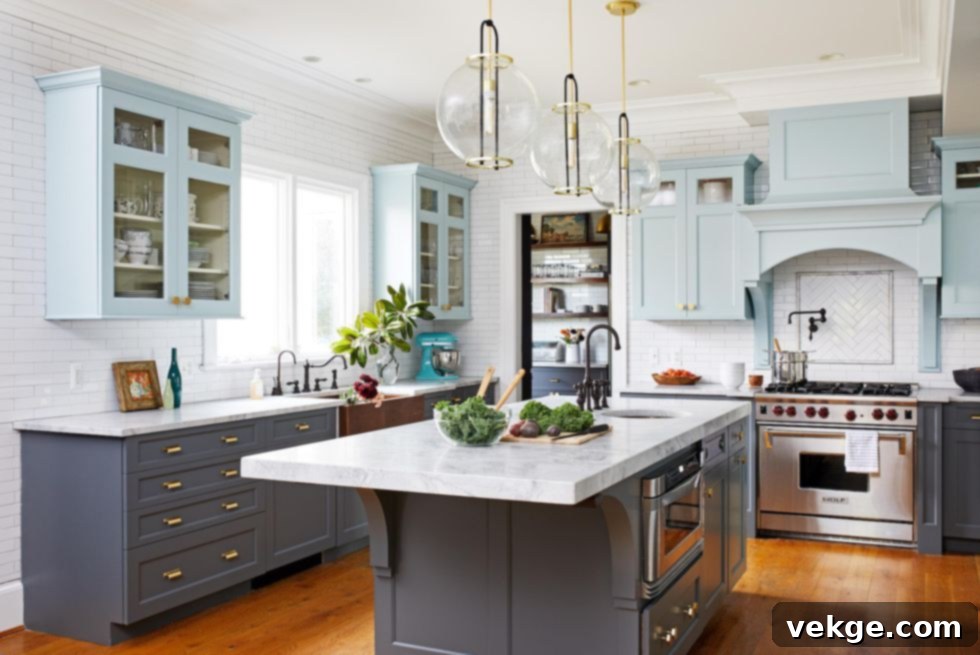
Dark gray has become a firm favorite among designers for its modern appeal and grounding presence. However, when introduced into a country-style kitchen, the concern often arises that it might appear too heavy or stark, potentially clashing with the inherent warmth and softness of the English country aesthetic. The brilliant solution lies in masterfully pairing it with a lighter, softer tone to achieve a perfect balance, creating a captivating visual effect that is both contemporary and classic.
The combination of dark gray cabinetry with pale blue walls is nothing short of mesmerizing. The deep, sophisticated tone of dark gray anchors the space, providing a sense of stability, elegance, and timelessness. Meanwhile, the gentle, ethereal quality of pale blue introduces an airy lightness and a touch of serene calm. This pairing beautifully echoes the natural beauty of a cloudy sky meeting the solid earth, fostering a truly harmonious and tranquil atmosphere. Imagine pale blue walls reflecting natural light, contrasting exquisitely with charcoal gray shaker cabinets that provide a sophisticated anchor to the room.
Do not hesitate to experiment with different shades and depths of these colors across various sections of your kitchen. For instance, you might opt for a slightly warmer dark gray for a central island and a cooler, lighter gray for perimeter cabinets, with pale blue serving as the unifying wall color. An English country kitchen thrives on this kind of thoughtful interplay of patterns, textures, and colors, all working in concert to create a refreshing, lively, and incredibly welcoming ambiance. Consider enhancing this sophisticated palette further with natural wood elements, crisp white ceramic dishware on open shelves, and antique brass or pewter hardware for a truly authentic touch.
6. The Enduring Charm of Creamy White for a Classic Country Vibe
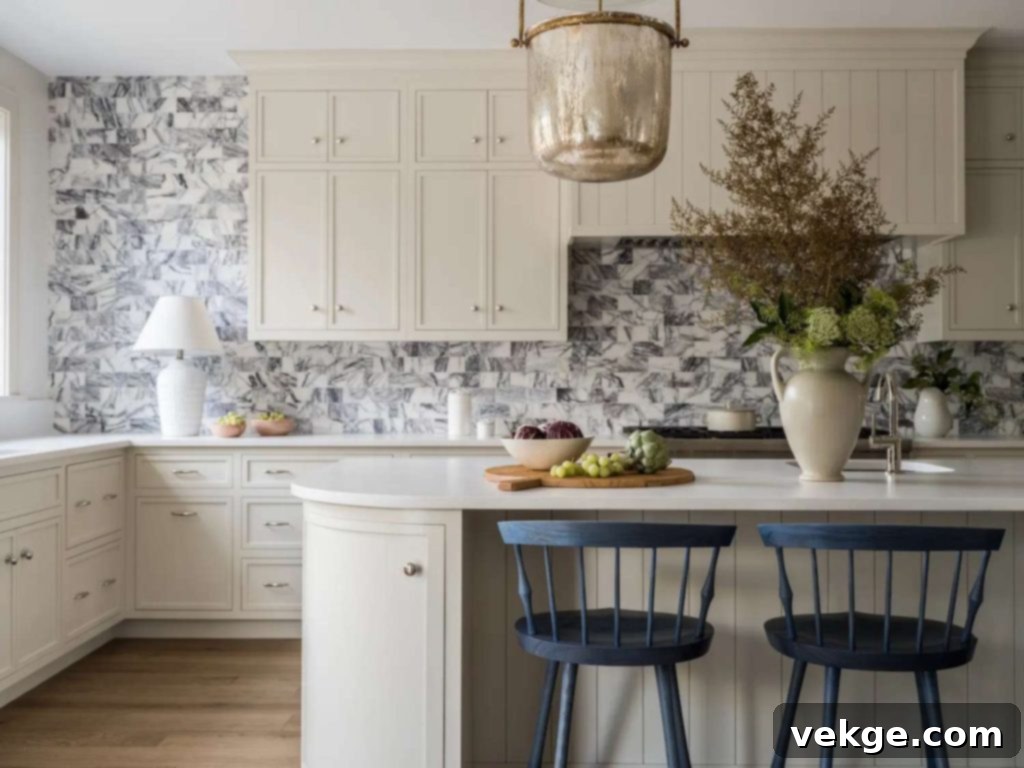
When it comes to designing an English country kitchen, choosing white is almost always a surefire path to success and a timeless aesthetic. The rustic and traditional charm that defines this style can be beautifully and effectively balanced with the right shade of white. However, the key to success lies in understanding the nuance of “white.” A stark, brilliant white, while popular in ultra-modern designs, often falls flat or feels too sterile in a country setting. Instead, it’s crucial to meticulously find the white shade that perfectly complements and enhances your kitchen’s interior, always leaning towards softer, richer tones.
Most experienced interior designers will wholeheartedly advise opting for a creamy white, an off-white, or a sophisticated shade of beige. These warmer whites are infused with subtle undertones of yellow, gray, or even a hint of peach, which makes them incredibly inviting and prevents them from feeling cold or clinical. They help soften the overall aesthetic of the kitchen, imbuing it with a gentle, welcoming aura that perfectly aligns with the cozy essence of English country design. Imagine antique white cabinets paired with warm butcher block countertops and a delicate vintage floral wallpaper – a true vision of rustic elegance and comfort.
Creamy whites also offer immense versatility, serving as a perfect backdrop for a myriad of natural wood textures, patinated metals, and colorful accessories. They allow other elements, such as a vibrant blue range cooker, a collection of gleaming copper pots, or a display of fresh wildflowers, to truly stand out. Furthermore, these shades brighten the space without sacrificing its character, reflecting light beautifully and making the kitchen feel more expansive and airy. Consider layering different white textures, such as beadboard paneling painted in a creamy white, alongside classic subway tiles in a similar hue, to add depth and tactile interest to your walls and backsplash.
7. Add a Hint of Mint for a Refreshing & Uplifting Look

Beyond the deeper, earthy greens like olive, lighter and more soothing shades such as mint green or soft sage work wonderfully in English country kitchens, particularly for those seeking a fresh, airy, and uplifting ambiance. These gentle, nature-inspired colors infuse a palpable sense of calm, freshness, and light into the space, creating an environment that feels both serene and invigorating.
Mint green, with its subtle blue undertones, evokes a delicate, botanical feel, reminiscent of lush spring foliage or a calm coastal breeze. It pairs exquisitely with crisp whites, warm creams, and natural light wood tones, enhancing its refreshing quality and ensuring the kitchen feels bright and open. Some interior designers might broaden this suggestion to include other muted, nature-inspired greens like a soft moss green or a pale avocado color for English kitchens, particularly when aiming for a slightly more vintage or heritage aesthetic.
However, it’s important to approach very dark or overly saturated shades of green with a degree of caution in this context. While strategic use of darker, richer greens like a deep forest green can be grounding, extremely dark hues might contradict the typically bright and airy feel of an English country kitchen, potentially making the space feel less open or even ‘shabby’ if not balanced meticulously. The goal is to maintain that delicate balance of rustic charm with an approachable lightness. Nevertheless, design is personal, and exceptions always exist, especially when considering unique home decor elements, abundant natural light, or a specific desired mood. For mint and similar light greens, consider them for cabinetry, a charming kitchen island, or even as an accent color on shelving or decorative pieces, always ensuring they contribute to the overall refreshing and welcoming atmosphere.
Beyond Color: Harmonizing Your English Country Kitchen
While color undoubtedly plays a paramount role in defining the character of your kitchen, a truly authentic English country kitchen is a symphony of elements working together in harmony. To complement your chosen color palette and achieve that quintessential charm, consider integrating these additional styling tips into your design:
- Natural Materials: Embrace the warmth and texture of natural wood (oak, pine, walnut) for countertops, flooring, and furniture. Incorporate natural stone like marble or granite for work surfaces, or classic ceramic tiles. Woven textures like wicker or linen add tactile richness and a homely feel.
- Layered Lighting: Create an inviting glow by combining practical task lighting (such as under-cabinet lights) with ambient lighting (elegant pendants over an island, ceiling fixtures) and decorative lighting (charming wall sconces, or even small lamps). Soft, warm light is crucial for enhancing the cozy atmosphere.
- Classic Hardware & Fixtures: Opt for timeless finishes that evoke a sense of history. Aged brass, antique bronze, pewter, or simple black iron are excellent choices for cabinet pulls, faucets, and light fixtures. These details add authenticity and character, completing the traditional look.
- Vintage & Collected Items: English country kitchens often feature a beautifully curated mix of old and new. Display vintage crockery, gleaming copper pots, antique wooden spoons, and charming artwork. Open shelving or glass-front cabinets are perfect for showcasing these treasured finds.
- Textiles: Introduce soft furnishings to add warmth and pattern. Think traditional patterned curtains (florals, ginghams, stripes, checks), elegant tablecloths, comfortable seat cushions, and practical yet decorative tea towels. Natural linen and cotton fabrics enhance the cozy, homely feel.
- Abundant Greenery: Fresh flowers and potted herbs are essential elements. They bring vibrant life, natural color, and delightful fragrance into the kitchen, powerfully reinforcing the connection to nature and making the space feel vibrant.
Conclusion: Crafting Your Perfect English Country Kitchen
Choosing the perfect color scheme for an English country-style kitchen can feel like a delightful yet extensive journey. With new trends constantly emerging alongside timeless classics, there’s a delicate balance to strike when selecting the hues that will define your culinary sanctuary. While some design philosophies champion nature-inspired themes and lighter shades for their ability to evoke spaciousness and serenity, others encourage a daring exploration of darker, moodier tones to add depth and character, proving the versatility of the style.
The common consensus, however, beautifully converges on a thoughtful and balanced approach: favoring lighter, muted shades as a primary base, and strategically pairing them with deeper, richer tones to introduce balance, striking contrast, and significant visual interest. This allows for both the classic, airy feel and the sophisticated, grounded elements that define a truly authentic English country aesthetic.
Whether you’re embarking on a full renovation of an existing English country kitchen or meticulously planning a brand-new one from scratch, the detailed color ideas and styling insights presented above are designed to empower and inspire you. They serve as a comprehensive guide, helping you make confident and correct choices that reflect your personal style while honoring the timeless charm of this beloved design movement. Your kitchen is more than just a room; it’s a reflection of your home’s soul, and with the right colors, it can become a truly enchanting and unforgettable space.
We hope you thoroughly enjoyed reading this guide and found it immensely inspiring. We’d love to hear your thoughts, favorite color combinations, and any personal experiences in the comment section below!
